Cold-Weather Tile Installation
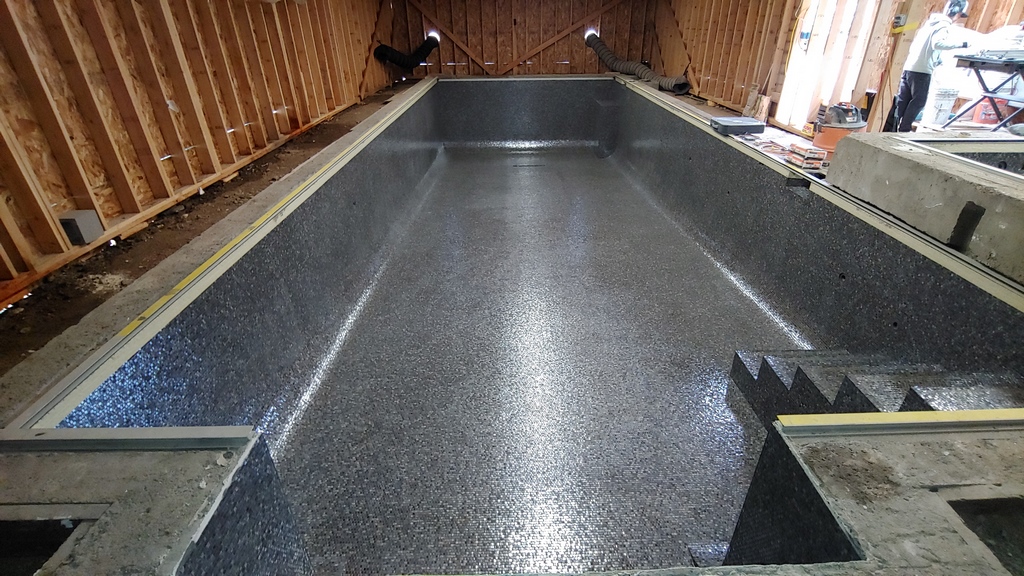

When you consider the long-term environmental exposure every pool tile installation endures, Amy Denny explains that it merits elevating installation methods, setting materials, and the installation environment. A deliberate and planned strategy is paramount, especially when working in cold temperatures.
By Amy Denny
For those of us who install tile in swimming pools, it’s pretty obvious to focus attention on tile selection, proper materials and installation best-practices. Controlling the installation environment is also a fundamental component of planning each project. This is because we know that environmental conditions during installation can dictate success or failure, no matter what products and materials are specified. Furthermore, when constructing something as expensive — and expansive — as fully tiled swimming pools, the risk factors and level of difficulty can dramatically rise as the temperature falls.
The challenge of working in extreme weather is a new topic for many builders as the demand for all-tile luxury pools continues to grow in cold-weather climates. We occasionally inspect tile failures as part of legal actions; and, while every situation is different with a variety of causal factors, failure to adequately control the installation and curing environment is commonly present on the list of factors that led to the installation malfunction.
In the real world, there are situations where it’s necessary to install tile during the colder timeframes. Perhaps a springtime or early summer event is dictating an “ideal” finish date. The client may just want to enjoy their pool and backyard during the summer months. Often times, ordinary construction delays — like permitting, project design revisions, material shortages, and labor scarcity — will push the tile installation timeline into the winter period.
Whatever the reason may be, there are important considerations tile installers must take into account when tackling a tile-installation project that lands when the mercury plunges.
THE TILE ITSELF
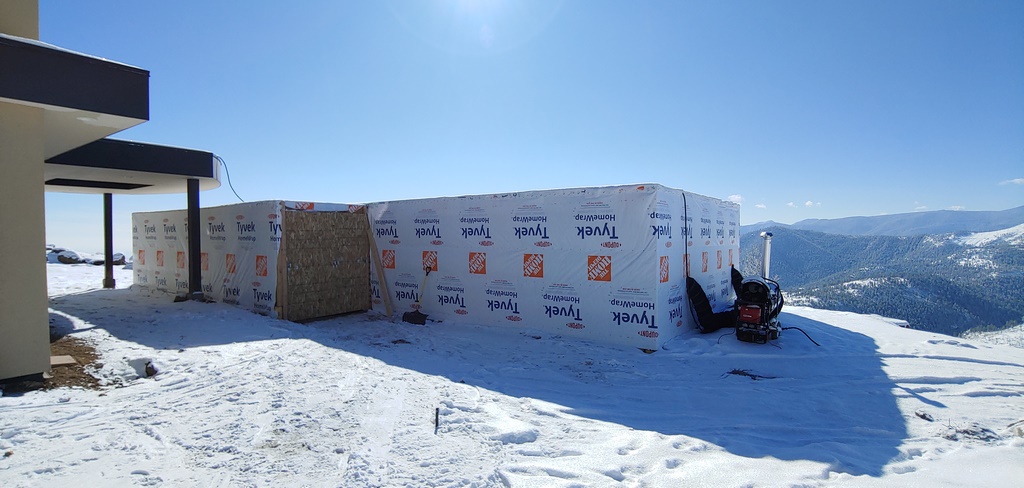
Ahead of managing the working conditions, a cold-weather installation begins with the type of tile we are being asked to install. Whenever possible, our scope includes the tile specification. This is because we understand the limitations of tile, modules, and mounting systems, and how these factors impact performance in the extreme exterior pool environment.
Sometimes, however, tile has already been specified, either by a homeowner, showroom designer, pool builder, or architect. Design and Architectural publications feature gorgeous coastal pools with sparkling water-in-transit features that inspire others to include similar elements in their #dreampool.
The challenge is that certain products, materials, and design implementations will function perfectly at 70 degrees, but can fail at 20. In all climates, but especially in climates that plunge into freezing temperatures, the most successful projects integrate the pool, tile, and material design in a manner that works as a system that withstands long-term environmental wear and tear.
Much of our work is located in regions with harsh winter conditions. In warm weather regions like Texas and Arizona, isolated winter storms, that can be devastating to pool tile installations, are becoming more common. It’s important to consider the impact freezing temperatures will have on tile and materials, and to make it known when a selection has been made that weakens the overall system. Even if tile has already been purchased, don’t be afraid to require modifications, or to pass on a job that you know may be destined to fail. At the end of the day, the installer will still be liable, even if someone else specified the material.
When presented with customer supplied tile -before committing to the project- I review tile selection and how it is designed into the pool. Then I consider the environment, and edit tile based on functionality. Perhaps because we work in such harsh climates, I tend to be conservative in my design approach, ensuring that ‘Function’ is firmly seated at the head of the table. The great thing is that porcelain tile has come a long way in recent years, so I feel like I have a vast selection of materials to choose from that increase performance without diminishing aesthetics.
Provide expertise that is in the best interest of the construction project budget, long term maintenance budget, anddesign aesthetics. Make material recommendations that withstand the conditions while meeting design expectations.
As an example, let’s take a water-in-transit pool design element such as a vanishing edge or an overflow of any kind: This is one of the most extreme environments in an operational pool design, with tile potentially exposed to wet/dry cycles, thermal cycles, and freeze/thaw cycles. Particularly in freeze/thaw climates, I don’t just look at a tile data sheet, see a green dot in the “approved for pools” column, and specify the tile. I will modify a specification from glass mosaics to a more durable porcelain tile, and/or upgrade setting materials from cementitious thinset to an epoxy. I maintain a high-impact tile design by concentrating sparkling iridescent glass mosaics in the experiential areas of the pool like an all-tile spa, a shallow sun-shelf, or submerged step entry.
Even taking these design precautions, it is important to inform the client about the additional risk freeze/thaw imparts onto any tile installation. Even if inclement weather only represents 1% of the year, it can diminish the integrity of the tile installation. For this reason, we require that glass mosaic projects remain full and heated to 45-50 degrees throughout the winter. I know, it sounds outrageous, but this is a conversational moment: We are creating a luxury product. A long-term commitment to the commensurate maintenance protocol will preserve its value while slowing the aging process.
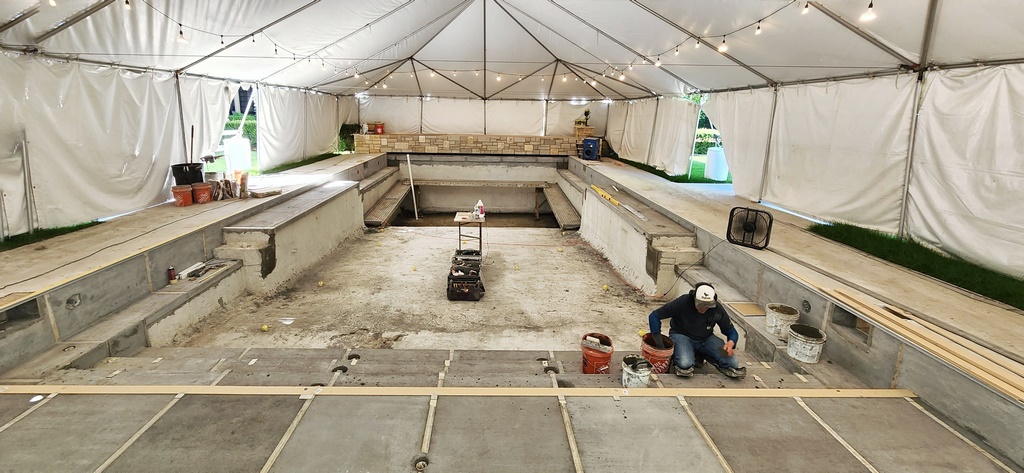
A BETTER CHOICE
A case study: We recently completed a plunge pool with vanishing edge, located in the northeast. The pool is waterfront, east-facing. Typically, a relatively temperate climate prevails at this protected location, however, winters can deliver a host of conditions that can be downright extreme.
The tile design was comprised of all-glass-mosaic features – including the vanishing edge and east-facing exterior wet wall. This presented a clear opportunity to edit materials. For the wet wall, we procured a large format, through-bodied porcelain tile. The entire submerged interior remained glass mosaics. The tile design was such that the vertical porcelain tile on the wet wall acted as the ‘knife edge.’ Because of this detail, we continued the glass mosaics along the weir, as the leading edge of glass was protected behind the porcelain tile.
In this design scenario, the mosaics remain submerged, even at the knife edge interface with porcelain tile. To be safe, we upgraded the glass setting material on the weir to epoxy and of course, included a movement joint between the glass and porcelain. We educated the client about maintenance and they are committed to year-round operation with enough heat to prevent water from freezing intermittently on the weir, wet wall, or waterline.
I feel confident in this tile design because the porcelain is going to take the brunt of the wind and the weather, while the glass tile will be protected beneath at least 3/16” of water at the leading knife edge. As long as the project operates as described, with 50-degree water pouring over that edge throughout the winter, it will avoid the freeze.
On the off chance there is a system failure, the freeze occurs at the porcelain interface, not a glass mosaic interface. Our experience has shown us that properly installed porcelain tiles can have a higher tolerance for freezing temperatures than a comparable glass mosaic installation. However, it’s important to mention that a bad freeze can be devastating to any tile installation system, no matter what the tile material.
The setting materials in freeze/thaw scenarios are equally as important as the tile: Moisture penetrating into grout and freezing in between tile can cause serious problems. This may result in saturated thinset, which then freezes, thaws out during the day, and then freezes again at night, and so on. That type of cycle compromises the installation.
We do our best to inform the homeowner, and their representatives, urging them to edit tile designs for function. Ultimately, the decision is theirs and we have to decide if we will take on the project/risk. The information we are trying to disseminate is that while glass tile IS impervious to moisture, and hence, is freeze/thaw proof, more goes into a successful system than tile alone.
Most glass tile manufacturers state their products are suitable to be installed in a pool environment, even in a freeze/thaw environment. Our hope is that additional details will be included in specification sheets when it comes to glass tile and pools.
When our client is locked in on a specification that we believe will age out prematurely, I ask the question: What does the customer want, and what do they expect aesthetically, versus what long-term maintenance/repairs are they prepared to manage? In other words, “How often would you like to invest in repairs, removal, or reinstallation?” Sometimes clients don’t understand that it might not be as simple as popping 1 or 2 tiles back in.
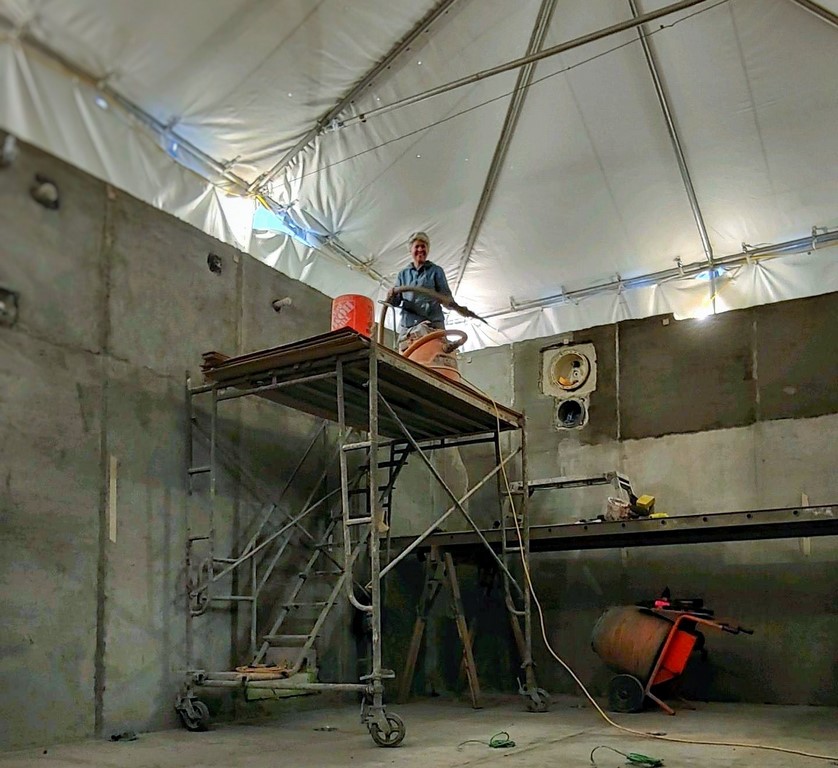
A pool tile installation is a system, comprised of many layers. It interfaces with other materials like plaster. A minor delamination may seem to have a quick fix; but, often times, the removal and repair requires waiting for our schedule to open up, draining the pool, building a tent, planning for cure times, and replacing other materials. So, what seems like a minor future expense could actually be quite significant.
At the end of the day, it doesn’t take much convincing once a client understands the full picture. The goal is to deliver a beautiful project that will endure the elements so they can spend their time experiencing the joy of water.
MAKING SPACE
We don’t have a big elephant in the room per se, but we do want to discuss The Big Tent in the Backyard. When it comes to installation quality, timeline, labor budget, and aesthetic detailing, the single greatest site difference between hot- and cold-weather tile installations is sufficient environmental protection. Whether we are talking about the installer, tile, or materials, managing through cold, wind and precipitation is far more rigorous than managing heat and sun exposure alone.
Protecting the work environment in a cold climate means building a structure over the pool, and that adds time and expense. Early on in our discussions with clients and their project team, we are direct about the required investment in necessary protection. If the client doesn’t value the necessary protection, we decline taking on the project.
Cold temps require climate control. Heating is expensive. ‘Climate control’ means temperature consistency, 24/7, throughout installation and during the cure time. A poorly constructed structure will not contain heat, could compromise the installation, not to mention the natural gas bill which can be astronomical. The heat is not for the installer; it is for the installation materials. The installer benefits during work hours, but the climate control continues for the entire duration that crew is offsite each day.
We keep digital thermometers in our working environments to record temps. An overnight frost to fresh thinset is guaranteed to weaken or lose bond. As one can imagine, building a structure or renting an event tent and heating the interior for up to 5/6 months could throw a project budget into some pretty wild numbers. Projects can be scheduled to take place during warmer months, but in cold climates if a definitive timeline is the most important goal, then budget could take a significant hit because the installation environment must be controlled if the project crosses into winter months.
While cold temperatures can be expensive to contend with, wind can be equally difficult to manage. In cold weather, the tenting plan is determined, the budget approved, and once managed, not a problem. In hot climates, shade and daily work schedule are tools that can overcome the elements. But wind is tough. Wind adds risk if tents are not properly built and secured. A windstorm could blow a tent structure into an expensive window system or into a neighbor’s yard. Even worse, it could be hazardous for workers.
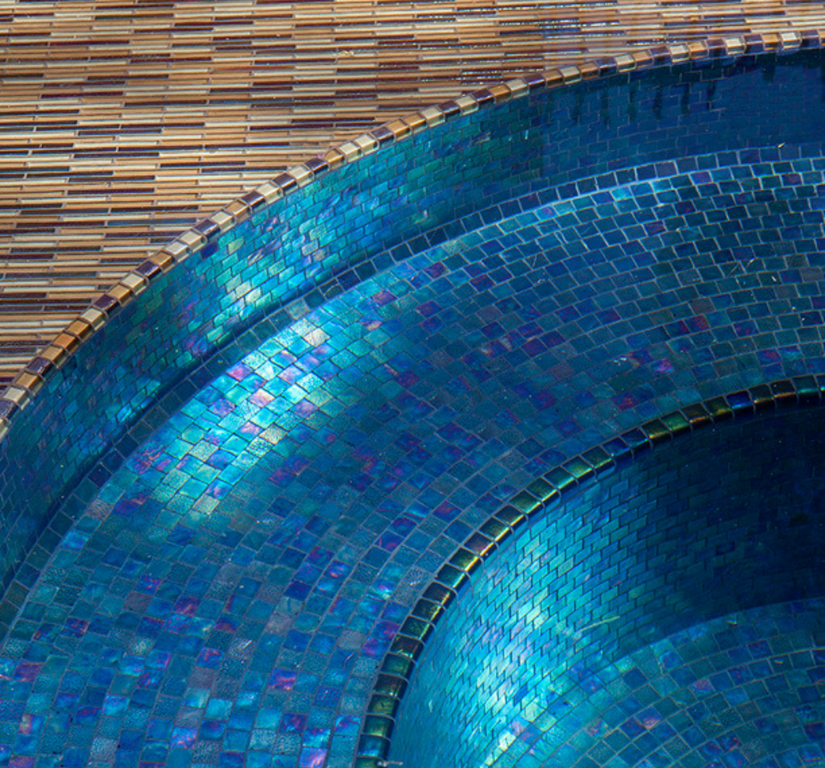
During installation, windy conditions quickly cause thinset to “skin over,” significantly impairing bond strength. Wind is an ordeal –dust becomes a bond-breaker when it blows onto a surface set to receive waterproofing, thinset, or any topical layers. Leaves and debris landing in a fresh coat of waterproofing, or freshly combed thinset, has to be removed. All of this slows down the work while creating a big mess.
ENCLOSURE NEEDS
A cold-weather structure can be a prefabricated and delivered, such as an event or party tent; or it can be built on site, typically by the pool builder or a general contractor. Either way, there are certain requirements that must be in place to protect the tile installation process.
- Adequate height: Although we don’t have an exact spec for height, there needs to be enough space to stand comfortably, to move freely, and to accommodate air circulation and lighting.
- Adequate footprint: We ask for five feet or greater around the pool perimeter so we can move ourselves, materials and equipment with ease and comfort, while maintaining a tidy working environment.
- Adequate lighting: Tile installation is precise, painstaking work, you must be able to see what you’re doing.
- Climate control: This is the big-ticket item. We’ve worked on jobs where the propane bill tops $1,000 per day. We focus on trying to keep the temperature moderate and consistent, both to control cost and facilitate the installation, especially setup and cure times. It doesn’t have to be 70 degrees. It can be 50 at the low end. We typically ask for temps in 58-to-65 range. That makes it comfortable for the physically vigorous work of tile installation, and makes the drying time fast enough to allow you to move quickly.
- Material/tool storage: This is easy to forget, but extremely important because it’s crucial to keep everything organized and ready. It can be a shed or container adjacent to the work area or a dedicated space on the deck inside the enclosure.
- No roof leaks: Seems obvious, but needs to be mentioned and followed, because if you do have a leak at the wrong time, you can ruin an entire installation.
- No water migration: This is true in any climate; you cannot install tile with water entering the work area. Most of the time, if water migration on the site is an issue, it’s already been addressed during the construction of the pool itself. If not, nothing moves forward until the issue is resolved.
- Adequate ventilation: Air must move or the conditions will be smelly, miserable and potentially hazardous. We find that in most cases, the heating and/or air-conditioning system provides enough circulation. If not, it’s a simple matter of bringing in fans.
- Power available: If you can’t plug in, it’s impossible to get much of anything done.
- Water available: You’ll need a clean and ready supply of water for material mixing. In cold weather, it’s important to be able to warm water up to room temperature. We fill barrels of water and if necessary, use a bucket heater. (In hot weather installs, we’ll bring in ice to keep the water cool.)
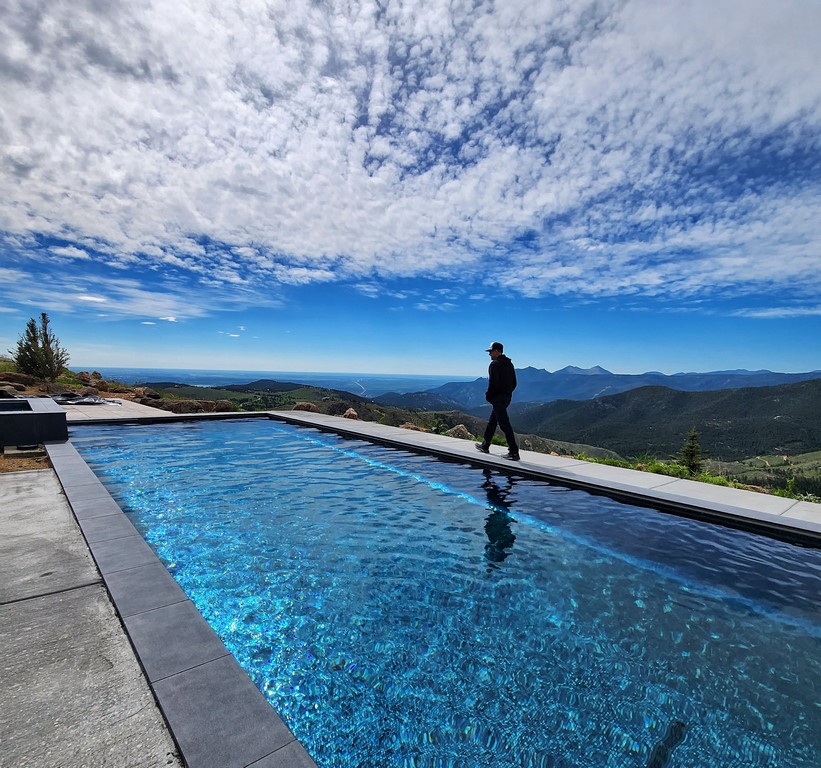
MATTERS OF CHOICE
Communication is the key, and we are abundantly clear about what a successful installation is going to require. We present options, both in terms of tile selection and what the client can save by waiting for warm weather if the resources aren’t there to protect the environment during the cold.
Some homeowners will be surprised by what it costs to rent a party tent for several months and may want to reconsider the timing. Others don’t blink an eye and have no problem with the costs.
Either way, we insist on doing the work correctly, under proper conditions, as we will be accountable for our work – whether it’s in mild weather or in temps that make your teeth chatter.
Amy Denny is co-owner of Alpentile, Coeur d’Alene, ID. For more than 20 years, she has avidly embraced all aspects of the tile industry, from product development, manufacturing and design, to her current role designing and installing glass-mosaic pools and spas. She works side-by-side with tile artisan and husband Luke Denny, who contributed to the above article. The Denny’s have also recently founded VESSEL Pools, (link) an innovative new company focused on producing pre-cast concrete plunge pools and spas.










